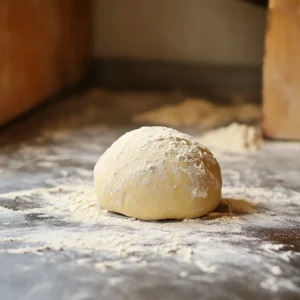Discover the art of creating an authentic Neapolitan pizza dough recipe that yields a soft, chewy crust with those distinctive charred edges.
This comprehensive guide will take you through every step, from understanding the rich history and cultural significance of Neapolitan pizza to selecting high-quality ingredients, mastering the kneading process, and perfecting fermentation, shaping, and baking techniques.
Whether you’re an experienced pizzaiolo or a curious beginner, this guide is designed to help you craft a pizza that truly embodies the tradition of Naples.
Introduction
Neapolitan pizza dough is celebrated worldwide for its delicate, airy crust and its signature cornicione, the puffy, charred edge that defines its character.
This unique pizza is not only a culinary delight but also a cultural icon steeped in tradition. In this article, we explore the traditional Neapolitan pizza dough recipe, discussing every crucial step from ingredient selection to high-temperature baking.
We also provide expert troubleshooting tips and practical advice to help you overcome common challenges. Prepare to dive into a detailed journey that will transform your home cooking and bring the authentic taste of Naples right into your kitchen, the historical Neapolitan Pizza Dough!
Historical Background and Cultural Significance
The Neapolitan pizza dough recipe has deep roots in the history and culture of Italy. Originating in 18th-century Naples, this humble dish began as a simple meal for the working class, made from basic ingredients like flour, water, yeast, and salt. Over time, it evolved into a celebrated culinary art form.
The simplicity of its ingredients belies the complexity of its flavor and texture, a testament to the power of traditional techniques passed down through generations.
- Cultural Heritage:
The Neapolitan Pizza Dough is recognized by the European Union as a Traditional Specialty Guaranteed product, Neapolitan pizza is a living cultural heritage. It is not just a food item; it is a symbol of Italian ingenuity and the art of making something extraordinary out of simple, quality ingredients. - Global Influence:
The techniques and principles behind the Neapolitan pizza dough recipe have influenced pizza-making around the world. From street vendors in New York City to gourmet pizzerias in Tokyo, the quest for the perfect crust continues to inspire chefs and home cooks alike. - UNESCO Recognition:
In recent years, the process and tradition behind making Neapolitan pizza have gained recognition from cultural institutions, underscoring its importance as an element of Italy’s intangible cultural heritage.
Essential Ingredients and Their Roles

The success of an authentic Neapolitan pizza dough recipe depends on a few carefully selected, high-quality ingredients. Each ingredient plays a critical role in developing the flavor, texture, and overall quality of the dough.
- Flour (Type 00):
00 flour is the cornerstone of Neapolitan pizza dough. Its fine grind and moderate gluten content provide the dough with the ideal elasticity needed for shaping, while ensuring a tender and airy crumb. The unique properties of 00 flour allow the dough to develop a silky texture that is both pliable and robust enough to hold traditional toppings. - Water:
Water is more than just a binding agent; it is essential for hydrating the flour and activating the yeast. Use lukewarm water (between 20°C and 25°C) to encourage optimal fermentation. The quality and mineral content of the water can also affect the flavor of your Neapolitan Pizza dough. - Yeast:
Yeast is responsible for the rise and texture of the dough. Traditionally, fresh baker’s yeast is preferred for its subtle flavor and reliable performance. However, dry yeast can also be used effectively. Yeast ferments the sugars in the flour, releasing gases that create the characteristic light and airy structure of Neapolitan pizza. - Salt:
Salt enhances the flavor of the Neapolitan Pizza Dough and strengthens the gluten network. It plays a crucial role in regulating yeast activity during fermentation. Adding salt at the correct stage of the dough-making process is essential to prevent it from inhibiting the yeast. - Olive Oil (Optional):
Although not always included in traditional recipes, a small amount of olive oil can enrich the Neapolitan Pizza Dough by adding moisture and tenderness. It also contributes a subtle, fruity flavor that complements the overall profile of the pizza. - Sugar (Optional):
A pinch of sugar may be added to accelerate the fermentation process and help with browning during baking. However, many traditional recipes forgo sugar in favor of a purer flavor.
Tools and Equipment
Having the right tools and equipment can make a significant difference in executing the Neapolitan pizza dough recipe successfully. Here’s a list of essential items to help you achieve the best results:
- Large Mixing Bowl or Dough Basin:
A spacious bowl is necessary for mixing and kneading the Neapolitan Pizza Dough thoroughly without crowding it. - Kitchen Scale:
Precision is key in Neapolitan pizza dough making. A kitchen scale ensures that you measure your flour, water, salt, and yeast accurately, leading to consistent results every time. - Stand Mixer with Dough Hook (Optional):
While traditionalists may prefer manual kneading, a stand mixer can make the process quicker and ensure an even mix, especially when preparing large batches. - Proofing Container:
Use a non-reactive container (glass or plastic) for the dough to rise undisturbed. This helps maintain a consistent temperature and prevents unwanted reactions with acidic ingredients. - Pizza Stone or Steel:
A pizza stone or steel is crucial for achieving a crispy, well-cooked crust. These tools mimic the high heat of a wood-fired oven, ensuring that your pizza cooks evenly and develops a delicious, blistered surface. - Thermometer:
A thermometer is useful for monitoring water temperature and ensuring that your fermentation environment is optimal.
For additional practical kitchen tips, you might also explore our How to Sharpen a Knife: A Comprehensive Guide.
Detailed Step-by-Step Process

1. Preparing the Leaven or Activating the Yeast
Begin by activating your yeast to ensure a robust fermentation process.
- Dissolve the Yeast:
In a small bowl, mix your yeast (whether fresh or dry) with a small amount of lukewarm water. Stir gently and let it sit for 5 to 10 minutes. The yeast should become frothy, indicating that it is active and ready to work. - Optional Pre-Ferment:
To further stimulate the yeast, add a teaspoon of 00 flour to the mixture. This small step can enhance the fermentation process and improve the dough’s rise.
2. Mixing and Kneading
Once your yeast is active, it’s time to combine it with the rest of the ingredients.
- Gradual Incorporation:
Place your measured 00 flour into a large mixing bowl. Slowly pour in the water mixed with the activated yeast, stirring continuously to ensure an even distribution. This gradual incorporation helps prevent clumping and promotes a uniform mixture. - Add the Salt:
When the dough begins to come together, add the salt. This timing is crucial because direct contact between salt and yeast can inhibit yeast activity. Stir well to combine all the ingredients. - Kneading Process:
The kneading process is vital to develop gluten, which gives the dough its structure and elasticity.- Manual Kneading: On a lightly floured surface, knead the dough by folding and stretching it for 8 to 10 minutes until it becomes smooth and elastic.
- Stand Mixer: Alternatively, use a stand mixer with a dough hook on low to medium speed for 5 to 7 minutes. The goal is to achieve a homogeneous dough that passes the windowpane test—when a small piece is stretched into a thin, translucent film without tearing.
3. First Fermentation (Bulk Fermentation)
After kneading, allow the dough to undergo its first rise.
- Initial Rising:
Shape the Neapolitan Pizza Dough into a ball and place it in a lightly oiled or floured bowl. Cover the bowl with a damp cloth or plastic wrap to maintain moisture. - Fermentation Time:
Let the Neapolitan Pizza Dough rise for 2 to 3 hours at room temperature (approximately 20-22°C). For a more developed flavor and improved texture, you can opt for a slow fermentation in the refrigerator for 8 to 24 hours. If refrigerating, be sure to bring the dough back to room temperature before proceeding to the next steps. - Importance of Fermentation:
Fermentation is where the magic happens. As the yeast ferments the sugars in the flour, it produces carbon dioxide, which creates air pockets in the dough. This process not only makes the dough light and airy but also enhances its flavor and digestibility.
4. Dividing and Forming Dough Balls
After the initial fermentation, it’s time to shape the dough for individual pizzas.
- Light Degassing:
Transfer the dough to a lightly floured work surface and gently press it to release excess gas. Avoid overworking the dough, as you want to preserve the air bubbles formed during fermentation. - Portioning:
Divide the dough into equal portions, usually between 200 to 250 grams per ball, depending on the size of pizza you desire. - Shaping into Balls:
Roll each portion between your palms to form a tight, smooth ball. Place the dough balls in a lightly floured container or tray, ensuring they are spaced apart so they do not stick together.
5. Second Fermentation (Proofing)
The second fermentation is a crucial step that allows the dough to relax and develop further.
- Final Rest:
Cover the dough balls with a clean cloth or a suitable lid, and let them rest for an additional 1 to 2 hours at room temperature. This final proofing period helps relax the gluten, making the dough easier to stretch, and contributes to a lighter, more tender final product.
6. Shaping and Topping
Now comes the creative part—transforming your dough into the perfect pizza base.
- Hand-Stretching the Dough:
Gently place a dough ball on a floured surface. Using your fingertips, press the dough from the center outward to form a disc. Leave a slightly thicker edge to create the characteristic cornicione, or puffy crust, of Neapolitan pizza. - Avoid Using a Rolling Pin:
Using a rolling pin can press out the air bubbles that are essential for a light, airy crust. Hand-stretching preserves these bubbles and ensures a better texture. - Adding Toppings:
Traditionally, Neapolitan pizza is topped with a thin layer of tomato sauce made from San Marzano tomatoes, fresh mozzarella (either fior di latte or buffalo mozzarella), a drizzle of olive oil, and a few basil leaves. Customize your toppings as desired, but remember that less is often more when it comes to preserving the delicate flavor of the crust.
7. Baking Methods and Tips

Baking is the final step where all your efforts come together to produce a perfect pizza.
- Wood-Fired Oven:
If you have access to a traditional wood-fired oven, preheat it to between 430°C and 480°C (800°F to 900°F). In such an oven, the pizza typically bakes in 60 to 90 seconds, developing a beautifully blistered and charred crust. - Domestic Oven:
For home ovens, preheat to the highest setting possible (usually between 250°C and 300°C or more). Place a pizza stone or steel in the oven for at least 30 minutes to simulate the high heat of a wood-fired oven. Bake your pizza for 5 to 8 minutes, keeping a close eye on it to achieve even browning. - Baking Techniques:
- Use a pizza peel to transfer the pizza onto the hot stone or steel.
- Rotate the pizza halfway through the baking process to ensure it cooks evenly.
- Immediately after baking, brush the crust lightly with olive oil to enhance flavor and add a touch of shine.
For a creative pairing, consider trying our Barbecue Shrimp Recipe.
Troubleshooting and Expert Tips
Even with a detailed recipe, you might encounter challenges. Here are some common issues and expert tips to ensure success:
- Sticky Dough:
If your neapolitan pizza dough is too sticky to handle, lightly dust your work surface with extra 00 flour or lightly oil it during the kneading process. This will help manage the stickiness without altering the hydration balance significantly. - Dry Dough:
Should your dough seem too dry, try adding a little extra water—remember that different batches of flour may absorb water differently. Adjusting the water content can help achieve the ideal consistency. - Enhancing Flavor:
For a more complex flavor profile, allow the dough to ferment slowly in the refrigerator for 8 to 24 hours. The extended fermentation time helps break down the starches and develop deeper flavors, making your pizza more aromatic and easier to digest. - Achieving a Puffy Cornicione:
The secret to a well-risen, airy edge lies in handling the dough gently during shaping. Avoid overworking it, and ensure your oven is preheated to a high enough temperature to create rapid expansion and blistering of the crust. - General Advice:
- Always weigh your ingredients carefully to ensure consistency from one batch to another.
- Use a timer to monitor each stage of the process—this is crucial for both fermentation and baking times.
- Practice makes perfect: the more you work with the dough, the better you will become at judging its readiness and handling it for the perfect stretch.
For additional hearty meal ideas, you might explore our Chicken and Potato Recipes.

Authentic Neapolitan Pizza Dough
Equipment
- Large mixing bowl
- Kitchen scale
- Stand Mixer with Dough Hook (Optional)
- Proofing Container
- Pizza Stone or Steel
- Thermometer
Ingredients
- 500 g water high-quality pizza flour
- 325 ml water lukewarm (20°C-25°C)
- 3 g fresh yeast or 1g dry yeast
- 10 g salt fine sea salt preferred
- 5 ml olive oil optional
- 1 tsp sugar optional, for faster fermentation
Instructions
- Prepare the yeast by dissolving it in a small bowl with lukewarm water. Let it sit for 5-10 minutes until frothy.
- Gradually mix the flour and activated yeast-water mixture in a large bowl, stirring continuously.
- Once the dough begins forming, add the salt and mix well to prevent direct contact with the yeast.
- Knead the dough for 8-10 minutes on a floured surface until smooth and elastic. If using a stand mixer, knead for 5-7 minutes on medium speed.
- Shape the dough into a ball and place it in a lightly oiled or floured bowl. Cover and let it rise at room temperature for 2-3 hours or refrigerate for 8-24 hours for deeper flavor.
- After fermentation, transfer the dough to a floured surface and divide it into 4 equal portions (about 200-250g each).
- Shape each portion into a tight dough ball and let them rest for another 1-2 hours at room temperature before stretching.
- To shape the pizza, gently stretch a dough ball with your hands, pressing from the center outward, leaving a thicker edge for the crust. Avoid using a rolling pin.
- Preheat a pizza stone or steel in your oven at the highest setting (250-300°C) for at least 30 minutes before baking.
- Add toppings of choice (traditional: San Marzano tomato sauce, fresh mozzarella, olive oil, and basil).
- Bake the pizza on the preheated stone or steel for 5-8 minutes, rotating halfway for even cooking. If using a wood-fired oven (430-480°C), bake for 60-90 seconds.
- Remove the pizza from the oven, brush the crust lightly with olive oil, and enjoy your homemade Neapolitan pizza!
Notes
FAQs – Frequently Asked Questions
1. What is the best flour for Neapolitan pizza dough?
00 flour is ideal due to its fine texture and moderate gluten content, which creates a tender yet elastic dough perfect for Neapolitan-style pizzas.
2. Can I use dry yeast instead of fresh yeast?
Yes, you can use dry yeast as a substitute. Just remember to adjust the quantity accordingly, as dry yeast is typically more concentrated than fresh yeast.
3. How long should the dough ferment?
Allow the dough to ferment for 2 to 3 hours at room temperature, or opt for a longer, slow fermentation in the refrigerator (up to 24 hours) for enhanced flavor and texture.
4. What temperature should I bake the pizza at?
For a wood-fired oven, aim for temperatures between 430°C and 480°C (800°F to 900°F). In a domestic oven, use the highest setting available, usually between 250°C and 300°C.
5. Can the dough be frozen?
Yes, you can freeze the dough after the first fermentation. Simply thaw it overnight in the refrigerator, then let it come to room temperature before shaping.
6. How do I achieve a light, airy crust?
A light, airy crust is achieved by ensuring proper hydration, thorough yet gentle kneading, and high-temperature baking. Additionally, careful hand-stretching helps preserve the air bubbles necessary for that perfect texture.
Conclusion
Mastering the authentic Neapolitan pizza dough recipe is both an art and a science. By using high-quality ingredients, following precise fermentation techniques, and baking at high temperatures, you can create a pizza with a light, flavorful crust and a beautifully puffed cornicione.
Each step, from mixing and kneading to shaping and baking, plays a crucial role in the final product. With patience and practice, you will be able to replicate the authentic taste of Naples right in your own kitchen.
For those who wish to delve even deeper into the world of Italian cuisine and culinary tradition, consider exploring further resources and recipes online. For instance, visit Pizza Napoletana Official for more insights into the traditional standards and practices behind this beloved pizza.
Buon appetito!


1 thought on “Neapolitan Pizza Dough Recipe: The Ultimate Guide to Authentic Italian Pizza”